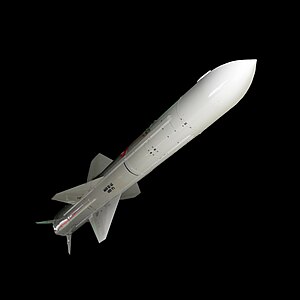Exocet missile
| Exocet | |
|---|---|

An AM39 aircraft-launched Exocet
|
|
| Type | Anti-ship missile |
| Place of origin | France |
| Service history | |
| In service | 1973 |
| Used by | See operators |
| Production history | |
| Designer | 1967–1970: Nord Aviation 1970–1974: Aérospatiale |
| Designed | 1967 |
| Manufacturer | 1979–1999: Aérospatiale 1999–2001: Aérospatiale-Matra 2001–present: MBDA |
| Produced | 1974 |
| Specifications | |
| Weight | 670 kilograms (1,480 lb) |
| Length | 4.7 metres (15 ft 5 in) |
| Diameter | 34.8 centimetres (1 ft 1.7 in) |
| Warhead | 165 kilograms (364 lb) |
|
|
|
| Engine |
solid propellant engine turbojet (MM40 Block 3 version) |
| Wingspan | 1.1 metres (3 ft 7 in) |
|
Operational
range |
70–180 kilometres (43–112 mi; 38–97 nmi) |
| Flight altitude | Sea-skimming |
| Speed |
Mach 0.92 1,134 kilometres per hour (705 mph) |
|
Guidance
system |
Inertial guidance and terminal active radar homing |
|
Launch
platform |
multi-platform:
|
solid propellant engine
multi-platform:
The Exocet (French for "flying fish") is a French-built anti-ship missile whose various versions can be launched from surface vessels, submarines, helicopters and fixed-wing aircraft.
The missile's name was given by M. Guillot, then the technical director at Nord Aviation. It is the French word for flying fish from the Latin name exocoetus, a transliteration of the Greek name for flying fish ἐξώκοιτος (exōkoitos), which literally means "lying down outside (ἒξω, κεῖμαι), sleeping outside", because it sometimes stranded itself in boats.
The Exocet is built by MBDA, a European missile company. Development began in 1967 by Nord as a ship-launched weapon named the MM 38. A few years later Aerospatiale and Nord merged. The basic body design was based on the Nord AS30 air-to-ground tactical missile. The air-launched Exocet was developed in 1974 and entered service with the French Navy five years later.
The relatively compact missile is designed for attacking small- to medium-size warships (e.g., frigates, corvettes and destroyers), although multiple hits are effective against larger vessels, such as aircraft carriers. It is guided inertially in mid-flight and turns on active radar late in its flight to find and hit its target. As a countermeasure against air defence around the target, it maintains a very low altitude during ingress, staying one–two m above the sea surface. Due to the effect of the radar horizon, this means that the target may not detect an incoming attack until the missile is only 6,000 m from impact. This leaves little time for reaction and stimulated the design of close-in weapon systems (CIWS).
Its rocket motor, which is fuelled by solid propellant, gives the Exocet a maximum range of 70 kilometres (43 mi; 38 nmi). It was replaced on the Block 3 MM40 ship-launched version of the missile with a solid-propellant booster and a turbojet sustainer motor which extends the range of the missile to more than 180 kilometres (110 mi; 97 nmi). The submarine-launched version places the missile inside a launch capsule.
...
Wikipedia
